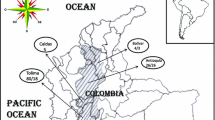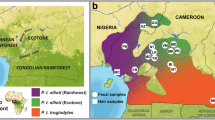Abstract.
The genetic structure of a population is closely connected to fundamental evolutionary processes and aspects of social behavior. Information on genetic structure is therefore instrumental for the interpretation of social behavior and evolutionary reconstructions of social systems. Gray mouse lemurs (Microcebus murinus) are basal primates endemic to Madagascar whose social organization is characterized by solitary foraging at night and communal resting during the day. Conflicting reports about population structure based on behavioral observations led us to examine the genetic structure of one population in detail in order to: (1) identify natural genetic units in this solitary primate, and (2) to test the assumption of current models of primate social evolution that solitary primates are organized in matrilines. DNA was extracted from tissue samples of 85 individuals from Kirindy forest to determine their variability at a 530 bp fragment of the mitochondrial D-loop and at six microsatellite loci. We found that this population was characterized by a great general diversity among mtDNA haplotypes, a pronounced sex difference in mtDNA haplotype diversity and spatial clustering of females with a particular haplotype, but low average relatedness among members of haplotype clusters. Specifically, we identified 13 different haplotypes, which were unevenly distributed among individuals. About 80% of all individuals, most of which were females or juvenile males, shared a single haplotype. Rare haplotypes were almost exclusively represented by single adult males, who apparently migrated into this population. One other haplotype was represented by a small group of females living at one edge of the study area. Microsatellite analysis revealed above-average relatedness among females with overlapping home ranges, as well as no signs of inbreeding, implying that male dispersal results in high levels of gene flow among matrilineal groups. We conclude that gray mouse lemur populations are hierarchically organized in small family units of closely related females that form stable sleeping groups, several of which are connected through a common mtDNA haplotype and form spatially distinct clusters. The presence of such matrilines supports a basic assumption of current models of primate social evolution.
Similar content being viewed by others
Author information
Authors and Affiliations
Additional information
Electronic Publication
Rights and permissions
About this article
Cite this article
Wimmer, B., Tautz, D. & Kappeler, P.M. The genetic population structure of the gray mouse lemur (Microcebus murinus), a basal primate from Madagascar. Behav Ecol Sociobiol 52, 166–175 (2002). https://doi.org/10.1007/s00265-002-0497-8
Received:
Revised:
Accepted:
Issue Date:
DOI: https://doi.org/10.1007/s00265-002-0497-8




